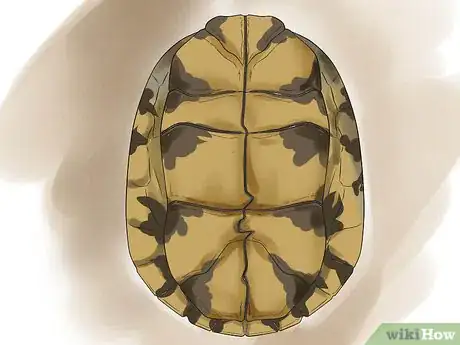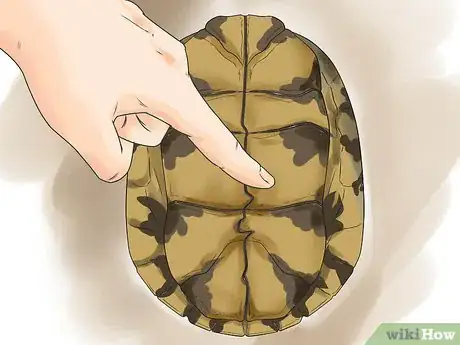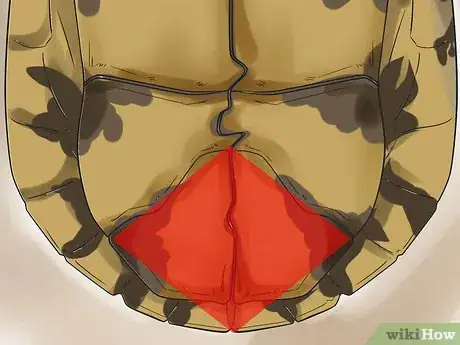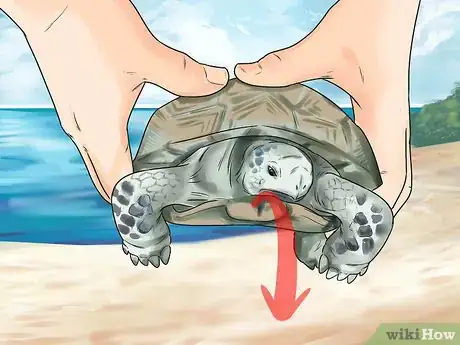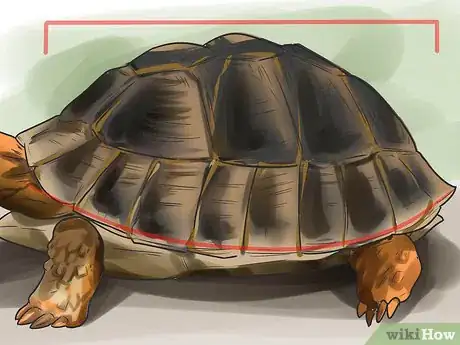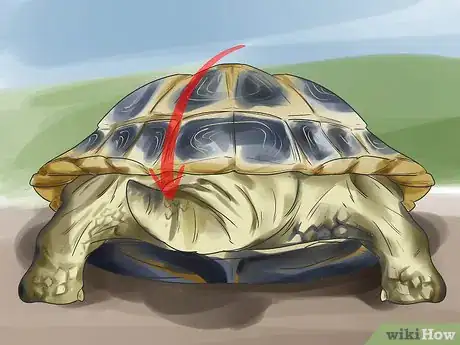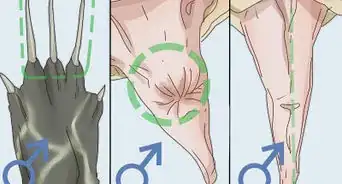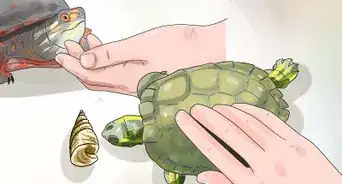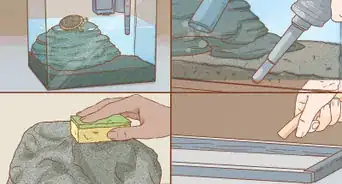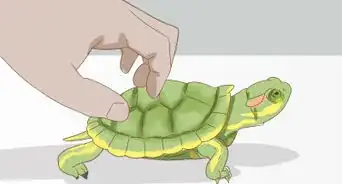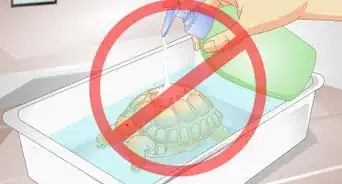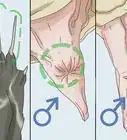This article was co-authored by Pippa Elliott, MRCVS. Dr. Elliott, BVMS, MRCVS is a veterinarian with over 30 years of experience in veterinary surgery and companion animal practice. She graduated from the University of Glasgow in 1987 with a degree in veterinary medicine and surgery. She has worked at the same animal clinic in her hometown for over 20 years.
wikiHow marks an article as reader-approved once it receives enough positive feedback. In this case, 85% of readers who voted found the article helpful, earning it our reader-approved status.
This article has been viewed 153,618 times.
Just bought a tortoise and wondering whether your new friend is male or female? Your tortoise is unlikely to just come right out and tell you, so you’ll need to do some investigation. Even if you don’t know what species your tortoise is, there are a few ways to determine its sex.
Steps
Determining Sex by Shell
-
1Pick up the tortoise. Hold the tortoise in both hands, being careful not to drop it. Hold the tortoise up high enough to be able to see underneath it. Do not flip the tortoise on its back. This is very stressful for the animal.
- If the tortoise is too big to lift above your head, try lifting it just slightly off the ground. Then, get down low enough to see underneath it.
-
2Look at the lower shell. The shell underneath the tortoise is called the plastron. Taking a look at this part of the shell is often the easiest way to tell a tortoise's sex.[1]
- If the plastron is indented, or concave, it is most likely male. The concave plastron helps the male to more easily mount the female.
- If the plastron is flat or convex, it is most likely female. A flat or bulging plastron helps the female carry more eggs.
-
3Touch the shell to confirm its shape. Determining the shape of the plastron might not be easy with only your eyes. You can feel the underside of the tortoise to determine if the shape is convex, flat, or concave.
-
4Look at the tail end of the plastron. This is called the anal scute. The scute will have an indent that is shaped like a "V" or a "U." This indent is just underneath where the tail comes out.[2]
- A male's anal scute usually forms a wider, more open angle, with the points farther from the marginals to allow the tail to move freely.
- A female's anal scute will form a tighter angle, with points close to the marginals. This offers her more protection.
-
5Put the tortoise back down. Don’t hold the tortoise in the air for longer than necessary. This can be stressful for them. Return the tortoise to its usual environment as quickly as possible.
-
6Look for sex based on coloration if possible. Not all species of tortoise can be sexed based on the color of their shell. However, in general, males will have somewhat brighter coloration than females. This can be especially true when they are mating.[3]
- Males are usually smaller than females, too. Red-footed tortoises are an exception. In this species, the males are generally the same size as the females.
-
7Examine the carapace. The carapace is the upper shell. In a few species, the shape of the carapace can reveal the sex of the tortoise. If you know your tortoise is one of these species, examine the shape of the shell for clues. For example:[4]
- Male hinge-back tortoises have more elongated bodies, while the females are rounder.
- Male Hermann's tortoises will be a little bit wider at the rear than the females of the same species.
Determining Sex by Tail
-
1Look at the tortoise’s tail. You may be able to do this without picking up the tortoise. If the tortoise is afraid, or in a new place, it might not appreciate being picked up. You can get down to the tortoise’s level to try to see the tail.
- Determining sex by the tail length is great for tortoises that you cannot pick up for whatever reason.
-
2Assess the tail’s length. There is no set length of a tortoise’s tail. However, males of most species have much longer tails than the females. You may notices the male's tail moving from side to side.
- A female’s tail is usually shorter than the end of a cotton swab.
- A male’s tale will be longer than that, but still not huge.
-
3Compare the tortoise’s tail to photographs. If you’ve never looked at a tortoise’s tail before, you might not have a sense of what is a long tail or a short tail. You can look up pictures of male and female tortoise tails for comparison.
- If you know the species of the tortoise, look up pictures of that specific species for accuracy.
Getting a Professional Opinion
-
1Call your veterinarian. Make sure they work with reptiles and are familiar with tortoises. If your veterinarian does not feel comfortable working with a tortoise, you can ask if they can recommend someone else you can call.[5]
-
2Bring the tortoise in to be sexed. You’ll need to make sure that the tortoise is fully mature. If the tortoise is not mature, the vet won’t be able to accurately determine the sex of the tortoise. Some species can take 15-20 years to become fully mature, so you may be waiting a while.[6]
-
3Ask a zoologist. If your vet is unable to see your tortoise, you can call your local zoo or aquarium. A professional there may be willing to look at the tortoise and determine its sex. You can also take a picture of the tortoise to bring in if bringing in the tortoise isn't viable.
- If you choose to bring in a photo, make sure to photograph the tail and the lower shell of the tortoise, as those are the most obvious indicators of a tortoise's sex.
Warnings
- Some species of tortoise are endangered. It is illegal to touch them in the wild.⧼thumbs_response⧽
- It is impossible to accurately sex a tortoise before it’s fully mature. This can take between 4 and 20 years, depending on the species of tortoise.⧼thumbs_response⧽
- Not all species of tortoise have the same markers for male and female. Learn about the species of tortoise before sexing.⧼thumbs_response⧽
References
- ↑ https://sites.google.com/site/tortoiselibrary/basics/sexing-tortoises
- ↑ https://sites.google.com/site/tortoiselibrary/basics/sexing-tortoises
- ↑ https://sites.google.com/site/tortoiselibrary/basics/sexing-tortoises
- ↑ https://sites.google.com/site/tortoiselibrary/basics/sexing-tortoises
- ↑ http://animals.mom.me/tell-sex-tortoise-6957.html
- ↑ https://sites.google.com/site/tortoiselibrary/basics/sexing-tortoises
About This Article
To sex tortoises, pick up the tortoise and examine its lower shell. If the lower shell is indented, or concave, it is most likely male. If the lower shell is flat or convex, it is most likely female. You can feel the lower shell with your fingers if you need to confirm its shape. Next, look at the end of the lower shell for a "V" or "U" shaped indent where the tail comes out. A male will have a noticeably wider, more open shape than a female. For tips on determining sex by examining the tail, read on!

